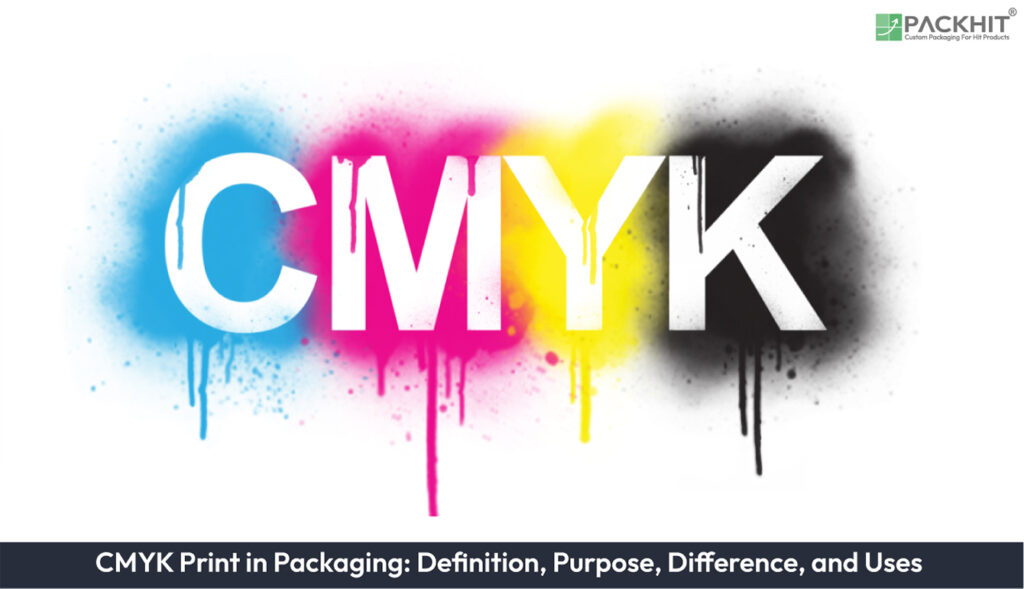CMYK printing is a widely used color model in the packaging industry, enabling manufacturers to produce vibrant, high-quality designs for custom packaging. The core properties of CMYK printing include sharp image resolution, scalability, adaptability to various materials, and cost-effectiveness, making it suitable for both small and large production runs.
CMYK is essential in packaging because it can reproduce colors accurately, enhance branding, and support eco-friendly practices. Compared to RGB, which is used for digital screens, CMYK uses ink to absorb light, requiring technical considerations like resolution, ink density, and substrate compatibility. Widely applied in food, cosmetic, and retail packaging, CMYK printing continues to evolve through digital innovations and sustainable solutions.
What is CMYK Printing?
CMYK stands for Cyan, Magenta, Yellow, and Key (Black), which are the four primary ink colors used in the printing process. Unlike RGB (Red, Green, Blue), which is used for digital screens, CMYK is specifically designed for physical printing. By layering these inks in varying proportions, CMYK printing creates a wide spectrum of colors suitable for packaging designs.
What are the Properties of CMYK Printing?
The core and dynamic properties of CMYK printing are mentioned below:
- Subtractive Color Mixing: CMYK uses subtractive color mixing, where inks absorb light to produce the desired hues.
- High Print Quality: CMYK printing ensures sharp, detailed images and text on packaging materials.
- Scalability: Suitable for small-scale and large-scale production runs.
- Adaptability: CMYK can be used on various substrates, including paper, cardboard, and flexible packaging films.
- Customizability: Allows for unique branding elements, such as logos, patterns, and vibrant color schemes.
- Cost Efficiency: Ideal for cost-effective printing without compromising quality.
Why is CMYK essential for Packaging?
CMYK printing plays a critical role in packaging by ensuring accurate color reproduction, enhancing brand visibility, and creating visually appealing designs. Manufacturers rely on CMYK to achieve consistent results across different packaging formats, making it a cornerstone of the printing industry.
What are the Key Benefits of CMYK Printing in Packaging?
The key benefits of CMYK printing in packaging are listed below:
Brand Recognition
CMYK printing keeps brand colors consistent across print runs. Printers apply the four color process, Cyan, Magenta, Yellow, and Key black, together with ICC profiles and press proofs to match a brand’s look. Convert RGB artwork to CMYK and check printed swatches. Use spot inks such as Pantone if an exact match is required. Brands such as food manufacturers, cosmetic makers, and retail producers rely on repeatable color for shelf recognition.
Versatility
CMYK prints on many packaging formats and materials. It supports three common formats: folding cartons, pressure-sensitive labels, and flexible pouches. It works on substrates such as coated paper, kraft board, and PET film. Digital CMYK also supports short runs and variable data printing for batch numbers or personalization.
Eco-Friendly Options
CMYK can use lower-impact inks and recyclable substrates. Options include soy or vegetable oil-based ink carriers, water-based varnishes, and low-VOC formulations. Choose single-material laminates and recyclable papers such as uncoated paper and kraft to improve end-of-life recovery and limit excessive ink coverage, if recyclability is a priority.
What is the Difference Between CMYK and RGB?
CMYK and RGB are color models, and their applications differ significantly. The RGB color model is used for digital displays, where light is emitted to create colors, whereas CMYK is used for physical printing, where inks absorb light. Converting RGB designs to CMYK is essential for accurate color reproduction in printed packaging.
Comparative Analysis of CMYK and RGB Print in Packaging
| Aspect | CMYK | RGB |
|---|---|---|
| Color Mixing | Subtractive (Ink-based) | Additive (Light-based) |
| Application | Physical Printing | Digital Screens |
| Color Range | Limited | Broader |
As shown in the table above, there are three aspects in which CMYK and RGB color models differ. These differences between CMYK and RGB give manufacturers three practical benefits. They match brand swatches on press and cut reprints, calculate ink use and press time for cost estimates, and choose substrates such as coated paper, kraft board, or PET film.
What are the Applications of CMYK Printing in Packaging?
CMYK printing is used across various packaging formats, including food packaging, cosmetic boxes, and retail product labels. Its versatility makes it suitable for both functional and aesthetic purposes.
Food Packaging
CMYK printing ensures vibrant and appealing designs for food packaging, helping brands stand out on shelves while adhering to safety standards.
Cosmetic Packaging
Cosmetic brands use CMYK printing to create luxurious and eye-catching designs that reflect their brand identity and attract customers.
Retail Packaging
Retail packaging benefits from CMYK printing by incorporating detailed product information, promotional graphics, and branding elements.
What are the Technical Considerations in CMYK Printing?
To achieve optimal results in CMYK printing, manufacturers must consider several technical factors, including resolution, ink density, and substrate compatibility. The proper calibration of printing equipment ensures accurate color reproduction and minimizes errors.
The technical considerations in CMYK printing are given below:
Resolution and Print Quality
High-resolution designs are essential for sharp and detailed prints. A resolution of 300 DPI (dots per inch) is recommended for packaging materials to ensure clarity and precision.
Ink Density and Color Accuracy
Maintaining the correct ink density is crucial for achieving consistent colors. Over-saturation can lead to smudging, while under-saturation may result in faded prints.

